Avoid Flush Cat Poop Down Your Toilet - Preserve Your House's Pipe Integrity
Avoid Flush Cat Poop Down Your Toilet - Preserve Your House's Pipe Integrity
Blog Article
Here in the next paragraph you will discover a lot of incredibly good expertise with regards to Can You Flush Cat Poop Down The Toilet?.

Intro
As feline owners, it's essential to bear in mind exactly how we deal with our feline friends' waste. While it might seem hassle-free to flush pet cat poop down the bathroom, this practice can have damaging consequences for both the setting and human health.
Ecological Impact
Flushing cat poop introduces hazardous pathogens and bloodsuckers into the water system, posing a considerable threat to aquatic environments. These contaminants can negatively affect aquatic life and concession water quality.
Health and wellness Risks
Along with ecological problems, flushing cat waste can also position health and wellness dangers to human beings. Pet cat feces might have Toxoplasma gondii, a bloodsucker that can cause toxoplasmosis-- a potentially severe ailment, particularly for expecting women and people with weakened immune systems.
Alternatives to Flushing
Luckily, there are much safer and extra liable means to deal with pet cat poop. Take into consideration the adhering to options:
1. Scoop and Dispose in Trash
One of the most common approach of getting rid of feline poop is to scoop it right into a biodegradable bag and toss it in the garbage. Be sure to make use of a specialized litter scoop and throw away the waste immediately.
2. Usage Biodegradable Litter
Select biodegradable feline litter made from materials such as corn or wheat. These clutters are environmentally friendly and can be safely disposed of in the trash.
3. Hide in the Yard
If you have a backyard, consider burying feline waste in a marked area away from vegetable gardens and water resources. Make certain to dig deep adequate to prevent contamination of groundwater.
4. Set Up a Pet Waste Disposal System
Invest in a pet waste disposal system specifically developed for feline waste. These systems utilize enzymes to break down the waste, minimizing odor and environmental effect.
Final thought
Responsible pet ownership expands past supplying food and sanctuary-- it likewise involves correct waste monitoring. By avoiding flushing cat poop down the commode and selecting alternate disposal methods, we can decrease our environmental impact and safeguard human wellness.
Why Can’t I Flush Cat Poop?
It Spreads a Parasite
Cats are frequently infected with a parasite called toxoplasma gondii. The parasite causes an infection called toxoplasmosis. It is usually harmless to cats. The parasite only uses cat poop as a host for its eggs. Otherwise, the cat’s immune system usually keeps the infection at low enough levels to maintain its own health. But it does not stop the develop of eggs. These eggs are tiny and surprisingly tough. They may survive for a year before they begin to grow. But that’s the problem.
Our wastewater system is not designed to deal with toxoplasmosis eggs. Instead, most eggs will flush from your toilet into sewers and wastewater management plants. After the sewage is treated for many other harmful things in it, it is typically released into local rivers, lakes, or oceans. Here, the toxoplasmosis eggs can find new hosts, including starfish, crabs, otters, and many other wildlife. For many, this is a significant risk to their health. Toxoplasmosis can also end up infecting water sources that are important for agriculture, which means our deer, pigs, and sheep can get infected too.
Is There Risk to Humans?
There can be a risk to human life from flushing cat poop down the toilet. If you do so, the parasites from your cat’s poop can end up in shellfish, game animals, or livestock. If this meat is then served raw or undercooked, the people who eat it can get sick.
In fact, according to the CDC, 40 million people in the United States are infected with toxoplasma gondii. They get it from exposure to infected seafood, or from some kind of cat poop contamination, like drinking from a stream that is contaminated or touching anything that has come into contact with cat poop. That includes just cleaning a cat litter box.
Most people who get infected with these parasites will not develop any symptoms. However, for pregnant women or for those with compromised immune systems, the parasite can cause severe health problems.
How to Handle Cat Poop
The best way to handle cat poop is actually to clean the box more often. The eggs that the parasite sheds will not become active until one to five days after the cat poops. That means that if you clean daily, you’re much less likely to come into direct contact with infectious eggs.
That said, always dispose of cat poop in the garbage and not down the toilet. Wash your hands before and after you clean the litter box, and bring the bag of poop right outside to your garbage bins.
https://trenchlesssolutionsusa.com/why-cant-i-flush-cat-poop/

We were introduced to that article about Don’t flush cat feces down the toilet from a friend on a different web page. Liked our post? Please share it. Help somebody else discover it. Bless you for your time. Come back soon.
Click Here Report this page